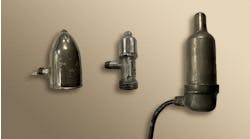BY ROBERT P. MADER
Of CONTRACTOR’s staff
SAN JOSE, CALIF. — Americans’ love affair with whirlpool tubs, hydronic towel warmers and other large consumers of hot water may be beginning to alter the domestic hot water market, a consulting firm here said.
Tankless and boiler water heaters equipped with advanced technologies are capturing the imagination of select classes of consumers, consulting firm Frost & Sullivan said.
New analysis from Frost & Sullivan, “U.S. Water Heating Equipment Markets,” reveals that this industry generated revenues totaling $1.85 billion in 2002. Total market revenues are expected to reach $2.35 billion in 2009.
New homes are getting bigger and more feature rich, especially in the bath, the firm noted. Greater demands for hot water create a need for larger initial water heater installations. Hydronic heating is a driver in some regions and is expected to increase in appeal as more installers are available and as pricing for PEX tubing declines, which it is doing. Finally, equipment that is markedly more cost efficient than old equipment drives sales of water heating equipment.
Engineers will be challenged to enhance the traditional tank-type water heater technology since these units are already highly efficient and economical, the consulting firm said. Moreover, any significant innovation will be expensive to the manufacturer and consumer alike, making those innovations unlikely to appear in the market.
Nevertheless, the higher levels of sophistication of tankless water heaters and light boilers provide scope for technological advancements.
“The greater complexity presents opportunities for additional controls and usage, which may bring previously untapped benefits to end users,” said Frost & Sullivan research analyst Jerry Davis.
Total market revenues for all residential and commercial water-heating products in the United States were $1.85 billion dollars in 2002. The lion’s share of that is in the residential sector, with $1.59 billion in revenues from sales of 9.47 million units. The light commercial sector generated $263 million in revenues from sales of 244,308 units.
In 2002, the tank-type residential water heating equipment market was 9.45 million total tank-type units shipped, generating $1.54 billion in manufacturers’ revenues. This accounts for 88% of the U.S. water heating equipment revenues. Tankless, non-point-of-use and light copper boilers generated $33.1 million and $18.2 million respectively, in residential revenues as well, elevating the residential market revenue total to $1.59 billion for 2002.
“There are some interesting developments in this market,” Davis said.
Copper-fin systems are increasing unit market share nearly 10 times faster than tank-type equipment in areas where gas boilers are already part of the mental landscape, and tankless water heaters are increasing their share of unit and revenue growth even faster, at about 12%.
The tank-type market is in no danger at this time, the consultant said, because both copper-fin and tankless markets are small, relatively speaking, “but every market grew from a single product, and things change much more rapidly now than in the past,” he said.
Solutions for heating water are definitely weather-related, but there is also a trend, increasing in momentum, towards greater hot water usage due to increases in residential devices that require hot water. In that sense, revenues might tend to become less dependent on weather and the traditional replacement market, and more dependent on upgrading current systems.
“Competing technologies are also encroaching on the traditional tank-type solutions, and we expect that trend to accelerate as consumers demand more available hot water from their current equipment,” Davis said. “The days of the 40-gal. gas or 50-gal. electric heater being the de facto new-install standard will probably end near the end of this forecast period [2009].”
Subtle improvements in ignition, insulation and packaging can be made to tank-type heaters. Manufacturers may also provide innovative designs and processes to overcome standby losses.
Copper-fin boilers are robust and reliable products but convincing owners of large tanks to switch to this more expensive technology will be difficult, Frost & Sullivan opined in its report. Collaborations with the hydronic heating segment, however, will help ensure greater market shares for both water heating equipment companies and hydronic heating equipment makers.
“Established or anticipated demand for lots of heated water is necessary for copper-fin sellers to succeed in the broader consumer marketplace,” Davis said.
Despite manufacturers’ best efforts to the contrary, tank prices are expected to increase because of mandatory improvements in efficiency, environmental and safety parameters. Expenses will also be incurred for changing blown insulation compounds to more environmentally friendly insulators such as pentanes.
“Costs of gas tank-type units are anticipated to rise dramatically due to the inclusion of vapor barrier technologies for preventing unintentional ignition of spilled combustible fluids and gases,” Davis said.

